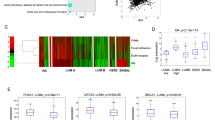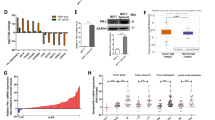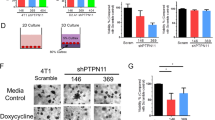Abstract
Many malignancies show increased expression of the epidermal growth factor (EGF) receptor family member ErbB3 (HER3). ErbB3 binds heregulin β-1 (HRGβ1) and forms a heterodimer with other ErbB family members, such as ErbB2 (HER2) or EGF receptor (EGFR; HER1), enhancing phosphorylation of specific C-terminal tyrosine residues and activation of downstream signaling pathways. ErbB3 contains six YXXM motifs that bind the p85 subunit of phosphoinositide 3 (PI3)-kinase. Previous studies demonstrated that overexpression of ErbB3 in mammary tumor cells can significantly enhance chemotaxis to HRGβ1 and overall metastatic potential. We tested the hypothesis that ErbB3-mediated PI3-kinase signaling is critical for heregulin-induced motility, and therefore crucial for ErbB3-mediated invasion, intravasation and metastasis. The tyrosines in the six YXXM motifs on the ErbB3 C-terminus were replaced with phenylalanine. In contrast to overexpression of the wild-type ErbB3, overexpression of the mutant ErbB3 did not enhance chemotaxis towards HRGβ1 in vitro or in vivo. We also observed reduced tumor cell motility in the primary tumor by multiphoton microscopy, as well as a dramatically reduced ability of these cells to cross the endothelium and intravasate into the circulation. Moreover, whereas mutation of the ErbB3 C-terminus had no effect on tumor growth, it had a dramatic effect on spontaneous metastatic potential. Treatment with the PI3-kinase inhibitor PIK-75 similarly inhibited motility and invasion in vitro and in vivo. Our results indicate that stimulation of the early metastatic steps of motility and invasion by ErbB3 requires activation of the PI3-kinase pathway by the ErbB3 receptor.
This is a preview of subscription content, access via your institution
Access options
Subscribe to this journal
Receive 50 print issues and online access
$259.00 per year
only $5.18 per issue
Buy this article
- Purchase on Springer Link
- Instant access to full article PDF
Prices may be subject to local taxes which are calculated during checkout





Similar content being viewed by others
References
Adam L, Vadlamudi R, Kondapaka SB, Chernoff J, Mendelsohn J, Kumar R . (1998). Heregulin regulates cytoskeletal reorganization and cell migration through the p21-activated kinase-1 via phosphatidylinositol-3 kinase. J Biol Chem 273: 28238–28246.
Amin DN, Campbell MR, Moasser MM . (2010). The role of HER3, the unpretentious member of the HER family, in cancer biology and cancer therapeutics. Semin Cell Dev Biol 21: 944–950.
Baselga J, Swain SM . (2009). Novel anticancer targets: revisiting ERBB2 and discovering ERBB3. Nat Rev Cancer 9: 463–475.
Burgess AW . (2008). EGFR family: structure physiology signalling and therapeutic targets. Growth Factors 26: 263–274.
Cain RJ, Ridley AJ . (2009). Phosphoinositide 3-kinases in cell migration. Biol Cell 101: 13–29.
Campbell MR, Amin D, Moasser MM . (2010). HER3 comes of age: new insights into its functions and role in signaling, tumor biology, and cancer therapy. Clin Cancer Res 16: 1373–1383.
Chandarlapaty S, Sawai A, Scaltriti M, Rodrik-Outmezguine V, Grbovic-Huezo O, Serra V et al. (2011). AKT inhibition relieves feedback suppression of receptor tyrosine kinase expression and activity. Cancer Cell 19: 58–71.
Chausovsky A, Waterman H, Elbaum M, Yarden Y, Geiger B, Bershadsky AD . (2000). Molecular requirements for the effect of neuregulin on cell spreading, motility and colony organization. Oncogene 19: 878–888.
Chaussade C, Rewcastle GW, Kendall JD, Denny WA, Cho K, Gronning LM et al. (2007). Evidence for functional redundancy of class IA PI3K isoforms in insulin signalling. Biochem J 404: 449–458.
Chiu CG, Masoudi H, Leung S, Voduc DK, Gilks B, Huntsman DG et al. (2010). HER-3 overexpression is prognostic of reduced breast cancer survival: a study of 4046 patients. Annals of Surgery 251: 1107–1116. 1110.1097/SLA.1100b1013e3181dbb1177e.
Di Cosimo S, Baselga J . (2010). Management of breast cancer with targeted agents: importance of heterogeneity. [corrected]. Nat Rev Clin Oncol 7: 139–147.
Engelman JA, Janne PA, Mermel C, Pearlberg J, Mukohara T, Fleet C et al. (2005). ErbB-3 mediates phosphoinositide 3-kinase activity in gefitinib-sensitive non-small cell lung cancer cell lines. Proc Natl Acad Sci USA 102: 3788–3793.
Engelman JA, Zejnullahu K, Mitsudomi T, Song Y, Hyland C, Park JO et al. (2007). MET amplification leads to gefitinib resistance in lung cancer by activating ERBB3 signaling. Science 316: 1039–1043.
Fiddes RJ, Campbell DH, Janes PW, Sivertsen SP, Sasaki H, Wallasch C et al. (1998). Analysis of Grb7 recruitment by heregulin-activated erbB receptors reveals a novel target selectivity for erbB3. J Biol Chem 273: 7717–7724.
Fujimoto N, Wislez M, Zhang J, Iwanaga K, Dackor J, Hanna AE et al. (2005). High expression of ErbB family members and their ligands in lung adenocarcinomas that are sensitive to inhibition of epidermal growth factor receptor. Cancer Res 65: 11478–11485.
Hayakawa M, Kawaguchi K, Kaizawa H, Koizumi T, Ohishi T, Yamano M et al. (2007). Synthesis and biological evaluation of sulfonylhydrazone-substituted imidazo[1,2-a]pyridines as novel PI3 kinase p110alpha inhibitors. Bioorg Med Chem 15: 5837–5844.
Hellyer NJ, Kim MS, Koland JG . (2001). Heregulin-dependent activation of phosphoinositide 3-kinase and Akt via the ErbB2/ErbB3 co-receptor. J Biol Chem 276: 42153–42161.
Hernandez L, Smirnova T, Kedrin D, Wyckoff J, Zhu L, Stanley ER et al. (2009a). The EGF/CSF-1 paracrine invasion loop can be triggered by heregulin beta1 and CXCL12. Cancer Res 69: 3221–3227.
Hernandez L, Smirnova T, Wyckoff J, Condeelis J, Segall JE . (2009b). in vivo assay for tumor cell invasion. Methods Mol Biol 571: 227–238.
Holbro T, Beerli RR, Maurer F, Koziczak M, Barbas III CF, Hynes NE . (2003). The ErbB2/ErbB3 heterodimer functions as an oncogenic unit: ErbB2 requires ErbB3 to drive breast tumor cell proliferation. Proc Natl Acad Sci USA 100: 8933–8938.
Iivanainen E, Paatero I, Heikkinen SM, Junttila TT, Cao R, Klint P et al. (2007). Intra- and extracellular signaling by endothelial neuregulin-1. Exp Cell Res 313: 2896–2909.
Jones RB, Gordus A, Krall JA, MacBeath G . (2006). A quantitative protein interaction network for the ErbB receptors using protein microarrays. Nature 439: 168–174.
Kalinowski A, Plowes NJ, Huang Q, Berdejo-Izquierdo C, Russell RR, Russell KS . (2010). Metalloproteinase-dependent cleavage of neuregulin and autocrine stimulation of vascular endothelial cells. FASEB J 24: 2567–2575.
Kedrin D, Wyckoff J, Boimel PJ, Coniglio SJ, Hynes NE, Arteaga CL et al. (2009). ERBB1 and ERBB2 have distinct functions in tumor cell invasion and intravasation. Clin Cancer Res 15: 3733–3739.
Ky B, Kimmel SE, Safa RN, Putt ME, Sweitzer NK, Fang JC et al. (2009). Neuregulin-1 beta is associated with disease severity and adverse outcomes in chronic heart failure. Circulation 120: 310–317.
Neri A, Welch D, Kawaguchi T, Nicolson GL . (1982). Development and biologic properties of malignant cell sublines and clones of a spontaneously metastasizing rat mammary adenocarcinoma. J Natl Cancer Inst 68: 507–517.
Olayioye MA, Badache A, Daly JM, Hynes NE . (2001). An essential role for Src kinase in ErbB receptor signaling through the MAPK pathway. Exp Cell Res 267: 81–87.
Prigent SA, Gullick WJ . (1994). Identification of c-erbB-3 binding sites for phosphatidylinositol 3′-kinase and SHC using an EGF receptor/c-erbB-3 chimera. Embo J 13: 2831–2841.
Sassen A, Rochon J, Wild P, Hartmann A, Hofstaedter F, Schwarz S et al. (2008). Cytogenetic analysis of HER1/EGFR, HER2, HER3 and HER4 in 278 breast cancer patients. Breast Cancer Res 10: R2.
Schade B, Lam SH, Cernea D, Sanguin-Gendreau V, Cardiff RD, Jung BL et al. (2007). Distinct ErbB-2 coupled signaling pathways promote mammary tumors with unique pathologic and transcriptional profiles. Cancer Res 67: 7579–7588.
Serra V, Scaltriti M, Prudkin L, Eichhorn PJ, Ibrahim YH, Chandarlapaty S et al. (2011). PI3K inhibition results in enhanced HER signaling and acquired ERK dependency in HER2-overexpressing breast cancer. Oncogene 30: 2547–2557.
Siegel PM, Ryan ED, Cardiff RD, Muller WJ . (1999). Elevated expression of activated forms of Neu/ErbB-2 and ErbB-3 are involved in the induction of mammary tumors in transgenic mice: implications for human breast cancer. EMBO J 18: 2149–2164.
Vijapurkar U, Kim MS, Koland JG . (2003). Roles of mitogen-activated protein kinase and phosphoinositide 3′-kinase in ErbB2/ErbB3 coreceptor-mediated heregulin signaling. Exp Cell Res 284: 291–302.
Wyckoff JB, Jones JG, Condeelis JS, Segall JE . (2000). A critical step in metastasis: in vivo analysis of intravasation at the primary tumor. Cancer Res 60: 2504–2511.
Wyckoff JB, Wang Y, Lin EY, Li JF, Goswami S, Stanley ER et al. (2007). Direct visualization of macrophage-assisted tumor cell intravasation in mammary tumors. Cancer Res 67: 2649–2656.
Xue C, Liang F, Mahmood R, Vuolo M, Wyckoff J, Qian H et al. (2006). ErbB3-dependent motility and intravasation in breast cancer metastasis. Cancer Res 66: 1418–1426.
Zhang J, Zhong W, Cui T, Yang M, Hu X, Xu K et al. (2006). Generation of an adult smooth muscle cell-targeted Cre recombinase mouse model. Arterioscler Thromb Vasc Biol 26: e23–e24.
Acknowledgements
We thank John Koland and the members of the Segall, Condeelis, Cox, Hodgson, and Hynes laboratories for comments and suggestions. JES is the Betty and Sheldon Feinberg Senior Faculty Scholar in Cancer Research. This work was supported by grants from the NIH (JES: CA77522 and CA100324); CA1U01105490 and CA100324 (JS Condeelis and J Wyckoff); RO1 GM55692 (JB); NIH P01 CA100324 (JB and ARB).
Author information
Authors and Affiliations
Corresponding author
Ethics declarations
Competing interests
The authors declare no conflict of interest.
Additional information
Supplementary Information accompanies the paper on the Oncogene website
Rights and permissions
About this article
Cite this article
Smirnova, T., Zhou, Z., Flinn, R. et al. Phosphoinositide 3-kinase signaling is critical for ErbB3-driven breast cancer cell motility and metastasis. Oncogene 31, 706–715 (2012). https://doi.org/10.1038/onc.2011.275
Received:
Revised:
Accepted:
Published:
Issue Date:
DOI: https://doi.org/10.1038/onc.2011.275
Keywords
This article is cited by
-
Changes in HER3 expression profiles between primary and recurrent gynecological cancers
Cancer Cell International (2023)
-
Role of glycosyltransferases in carcinogenesis; growth factor signaling and EMT/MET programs
Glycoconjugate Journal (2022)
-
Reverse transendothelial cell migration in inflammation: to help or to hinder?
Cellular and Molecular Life Sciences (2017)
-
Effects of neuregulin-1 administration on neurogenesis in the adult mouse hippocampus and characterization of immature neurons along the septotemporal axis
Scientific Reports (2016)
-
Increased expression of MyD88 and association with paclitaxel resistance in breast cancer
Tumor Biology (2016)



